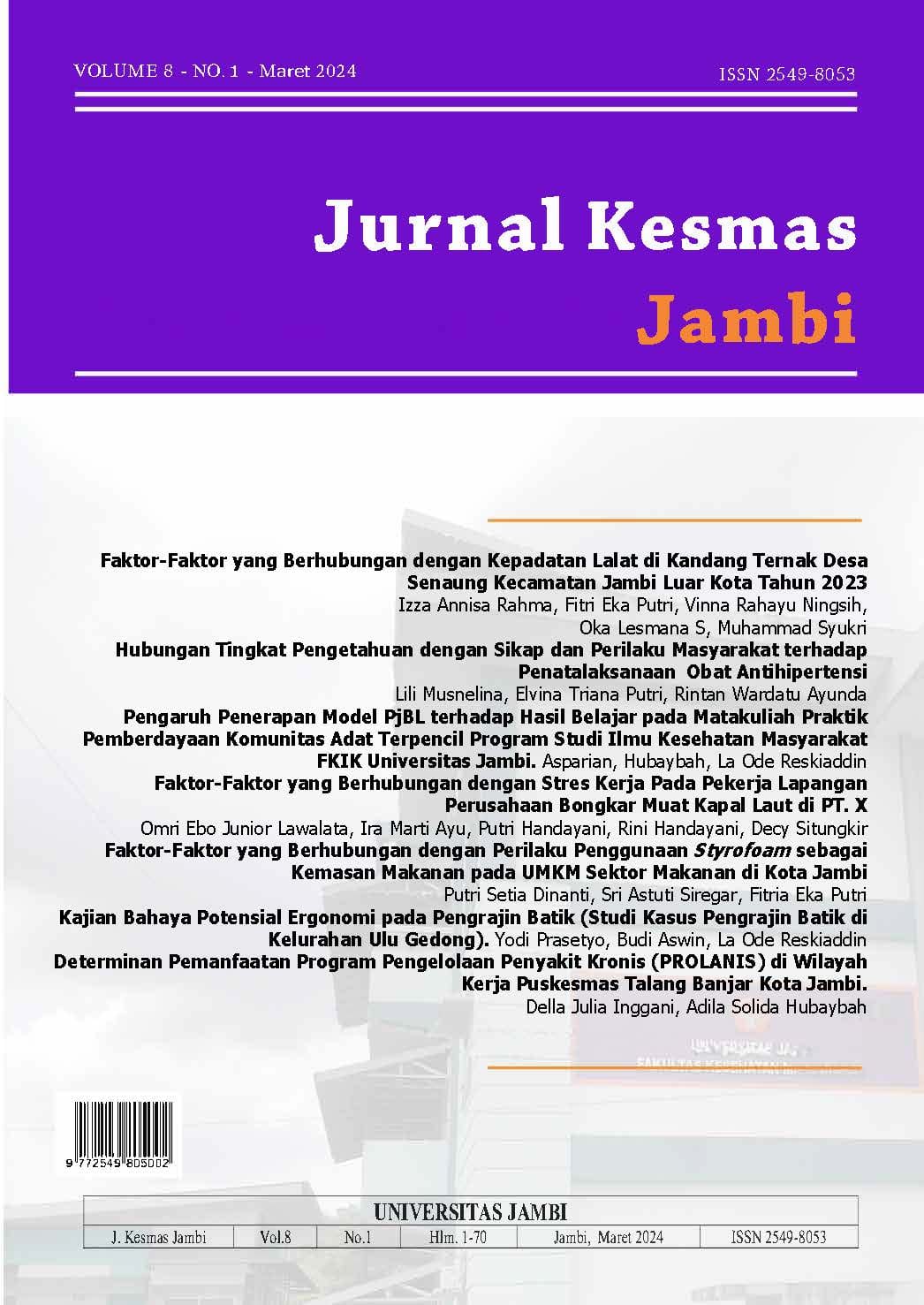Determinan Pemanfaatan Program Pengelolaan Penyakit Kronis (PROLANIS) di Wilayah Kerja Puskesmas Talang Banjar Kota Jambi
DOI:
https://doi.org/10.22437/jkmj.v8i1.31176Keywords:
Determinan, Pengelolaan, Prolanis, penyakit kronis, BPJS kesehatanAbstract
Abstract
Background: Talang Banjar Community Health Center is a community health center with the lowest Controlled Prolanist Participant Ratio (RPPT) in Jambi City, namely 0.55% from ≥ 5% set by BPJS. Of the 185 patients diagnosed with diabetes mellitus, only 39 patients were registered as pronalis participants and only 1 patient was controlled on prolanis. Meanwhile, of the 658 diagnosed with hypertension, 36 patients were registered as pronalis participants and only 3 patients were controlled on prolanis. Researchers aim to analyze the determinants of utilization of the chronic disease management program (prolanis) in the working area of the Talang Banjar Community Health Center, Jambi City.
Research Method: This type of research is quantitative research with a cross sectional study design. The total population in this study was 75 respondents. The sample in this study was selected using the Total Sampling Technique, namely all prolanis participants who were registered at the Talang Banjar Community Health Center, Jambi City. The dependent variable was the use of prolanis and the independent variables were age, gender, education, employment, knowledge, accessibility, attitude of health workers, and perception of disease. Data analysis used the chi square test.
Research Results: There is a relationship between education (p = 0,049), knowledge (p = 0,000), accessibility (p = 0,043), and perception of disease (0,020) with the use of prolanis. There was no relationship between age (p = 0,254), gender (p = 0,383), occupation (p = 1,000), and attitude of health workers (p = 0,320) with the use of prolanis.
Conclusion: There is a relationship between education, knowledge, accessibility and perception of disease with the use of prolanis. There is no relationship between age, gender, occupation and attitude of health workers with the use of prolanis.
Keywords: Determinants, Utilization of Prolanis, Diabetes Mellitus, Hypertension and Prolanis BPJS Health Participants
Downloads
Downloads
Published
Issue
Section
License
Copyright (c) 2024 Della Inggani, Adila Solida, Hubaybah Hubaybah

This work is licensed under a Creative Commons Attribution 4.0 International License.
Proposed Creative Commons Copyright Notices
1. Proposed Policy for Journals That Offer Open Access
Authors who publish with this journal agree to the following terms:
- Authors retain copyright and grant the journal right of first publication with the work simultaneously licensed under a Creative Commons Attribution License that allows others to share the work with an acknowledgement of the work's authorship and initial publication in this journal.
- Authors are able to enter into separate, additional contractual arrangements for the non-exclusive distribution of the journal's published version of the work (e.g., post it to an institutional repository or publish it in a book), with an acknowledgement of its initial publication in this journal.
- Authors are permitted and encouraged to post their work online (e.g., in institutional repositories or on their website) prior to and during the submission process, as it can lead to productive exchanges, as well as earlier and greater citation of published work (See The Effect of Open Access).
Proposed Policy for Journals That Offer Delayed Open Access
Authors who publish with this journal agree to the following terms:
- Authors retain copyright and grant the journal right of first publication, with the work [SPECIFY PERIOD OF TIME] after publication simultaneously licensed under a Creative Commons Attribution License that allows others to share the work with an acknowledgement of the work's authorship and initial publication in this journal.
- Authors are able to enter into separate, additional contractual arrangements for the non-exclusive distribution of the journal's published version of the work (e.g., post it to an institutional repository or publish it in a book), with an acknowledgement of its initial publication in this journal.
- Authors are permitted and encouraged to post their work online (e.g., in institutional repositories or on their website) prior to and during the submission process, as it can lead to productive exchanges, as well as earlier and greater citation of published work (See The Effect of Open Access).




 p-ISSN :
p-ISSN :  e-ISSN :
e-ISSN : 


